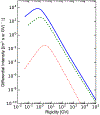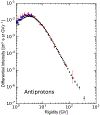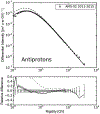Solution of Heliospheric Propagation: Unveiling the Local Interstellar Spectra of Cosmic-ray Species
- PMID: 34711991
- PMCID: PMC8549760
- DOI: 10.3847/1538-4357/aa6e4f
Solution of Heliospheric Propagation: Unveiling the Local Interstellar Spectra of Cosmic-ray Species
Abstract
Local interstellar spectra (LIS) for protons, helium, and antiprotons are built using the most recent experimental results combined with state-of-the-art models for propagation in the Galaxy and heliosphere. Two propagation packages, GALPROP and HelMod, are combined to provide a single framework that is run to reproduce direct measurements of cosmic-ray (CR) species at different modulation levels and at both polarities of the solar magnetic field. To do so in a self-consistent way, an iterative procedure was developed, where the GALPROP LIS output is fed into HelMod, providing modulated spectra for specific time periods of selected experiments to compare with the data; the HelMod parameter optimization is performed at this stage and looped back to adjust the LIS using the new GALPROP run. The parameters were tuned with the maximum likelihood procedure using an extensive data set of proton spectra from 1997 to 2015. The proposed LIS accommodate both the low-energy interstellar CR spectra measured by Voyager 1 and the high-energy observations by BESS, Pamela, AMS-01, and AMS-02 made from the balloons and near-Earth payloads; it also accounts for Ulysses counting rate features measured out of the ecliptic plane. The found solution is in a good agreement with proton, helium, and antiproton data by AMS-02, BESS, and PAMELA in the whole energy range.
Keywords: ISM: general; Sun: heliosphere; cosmic rays; diffusion; elementary particles; interplanetary medium.
Figures















References
-
- Abe K, Fuke H, Haino S, et al. 2016, ApJ, 822, 65
-
- Abeysekara AU, Alfaro R, Alvarez C, et al. 2013, APh, 50, 26
-
- Accardo L, et al. 2014, PhRvL, 113, 121101 - PubMed
-
- Acharya BS, Aguilar M, Aisa D, et al. 2013, APh, 43, 3
-
- Ackermann M, Ajello M, Atwood WB, et al. 2012, ApJ, 750, 3
Grants and funding
LinkOut - more resources
Full Text Sources
